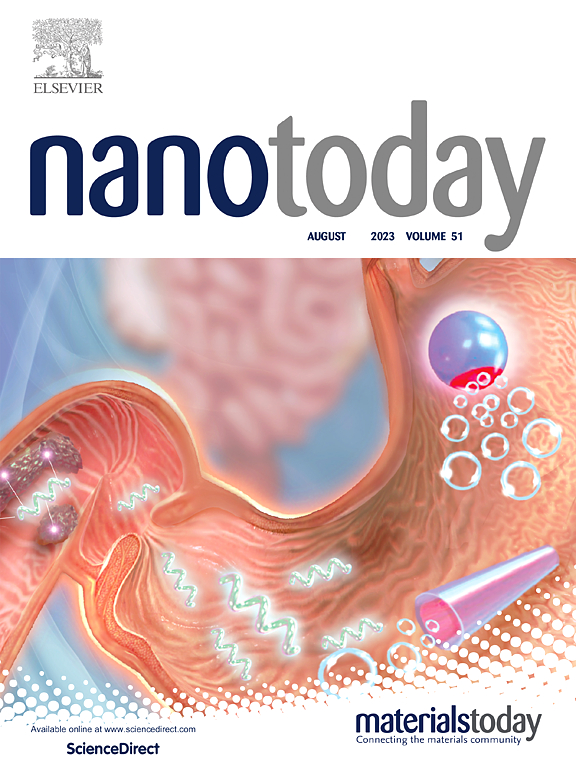近红外光诱导的自组装镧系纳米粒子增强放射增敏和持续肿瘤治疗监测
IF 10.9
1区 材料科学
Q1 CHEMISTRY, MULTIDISCIPLINARY
引用次数: 0
摘要
肿瘤放疗耐药是实现最佳放疗效果的重要障碍,促使放射增敏剂不断出现。为了增强放射增敏剂在肿瘤部位的保留,从而增强其放射增敏效果,研究人员开发了一种新型的纳米颗粒聚集平台(DH&UH NPs),可响应第二种近红外光,集成了放射增敏和生物成像功能。该平台由透明质酸衍生物修饰的镧系下转换纳米粒子(DH NPs)和镧系上转换纳米粒子(UH NPs)组成。在980 nm的激光照射下,UH NPs有效地产生紫外光,紫外光诱导UH NPs表面结合的NB分子上的羟基转化为醛基。醛基与UH - NPs上的氨基和DH - NPs上的联胺基反应,形成稳定的纳米颗粒聚集体。这种创新的设计不仅延长了肿瘤成像的时间,而且确保了放射增敏剂在肿瘤部位的持续保留。此外,HA衍生物中的有机二硒键作为放射增敏剂,在x射线照射下产生丰富的活性氧,从而显著增强了放射增敏效果。因此,这种创新的方法有望成为长期肿瘤成像和实现理想放射治疗效果的多功能工具。本文章由计算机程序翻译,如有差异,请以英文原文为准。
Near-infrared light-induced self-assembled lanthanide nanoparticles for boosted radiosensitization and persistent tumor therapy monitoring
Cancer radiotherapy resistance is a significant barrier to achieving optimal radiotherapy outcomes, prompting the continuous emergence of radiation sensitizing agents. To enhance the retention of radiosensitizers at tumor sites and thereby amplify their radiosensitizing effects, a novel nanoparticle aggregation platform (DH&UH NPs) responsive to second near-infrared light was developed, integrating radiosensitization and biological imaging functionalities. The platform is comprised of hyaluronic acid derivatives modified lanthanide-doped down-conversion nanoparticles (DH NPs) and lanthanide-doped upconversion nanoparticles (UH NPs). Under 980 nm laser irradiation, UH NPs efficiently generate UV light, which induces a tramsformation of the hydroxyl groups on the surface-bound NB molecules of the UH NPs into aldehyde groups. The aldehyde groups would react with the amino groups on UH NPs and the hydrazine groups of DH NPs, forming stable nanoparticle aggregates. This innovative design not only prolongs the duration of tumor imaging but also ensures sustained retention of the radiosensitizer at the tumor site. Furthermore, the organic diselenide bond in HA derivatives, serving as a radiosensitizer, generated abundant reactive oxygen species under X-ray radiation, thereby significantly enhancing the radiosensitization effect. Therefore, this innovative approach holds great promise as a versatile tool for long-term tumor imaging and achieving ideal radiation therapy effects.
求助全文
通过发布文献求助,成功后即可免费获取论文全文。
去求助
来源期刊

Nano Today
工程技术-材料科学:综合
CiteScore
21.50
自引率
3.40%
发文量
305
审稿时长
40 days
期刊介绍:
Nano Today is a journal dedicated to publishing influential and innovative work in the field of nanoscience and technology. It covers a wide range of subject areas including biomaterials, materials chemistry, materials science, chemistry, bioengineering, biochemistry, genetics and molecular biology, engineering, and nanotechnology. The journal considers articles that inform readers about the latest research, breakthroughs, and topical issues in these fields. It provides comprehensive coverage through a mixture of peer-reviewed articles, research news, and information on key developments. Nano Today is abstracted and indexed in Science Citation Index, Ei Compendex, Embase, Scopus, and INSPEC.
 求助内容:
求助内容: 应助结果提醒方式:
应助结果提醒方式:


